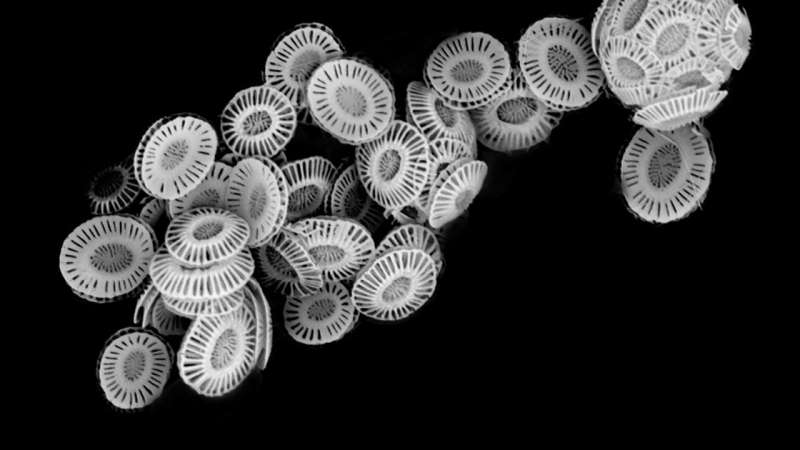This article has been reviewed according to Science X's editorial process and policies. Editors have highlighted the following attributes while ensuring the content's credibility:
fact-checked
peer-reviewed publication
trusted source
proofread
Microscopic chalk discs in oceans play a key role in Earth's carbon cycle by propagating viruses

A Rutgers-led team of scientists studying virus-host interactions of a globally abundant, armor-plated marine algae, Emiliania huxleyi, has found that the circular, chalk plates the algae produce can act as catalysts for viral infection, which has vast consequences for trillions of microscopic oceanic creatures and the global carbon cycle.
"In a drop of seawater, there will be about 1,000 to 10,000 E. huxleyi cells, and about 10 million viruses," said Kay Bidle, a professor in the Department of Marine and Coastal Sciences at Rutgers School of Environmental and Biological Sciences (SEBS) and a senior author on the study. "They're all in a sort of arms race against each other and we are studying it to see how it plays out and impacts Earth's carbon cycle."
Reporting in Science Advances, the researchers said they discovered, through observations both in the ocean and in the laboratory, that the chalk (calcium carbonate) plates, called coccoliths, are a previously unrealized central player in viral infections that can collapse phytoplankton blooms the size of some countries within weeks.
"Coccoliths can act as catalysts for death, delivering viruses directly to algae cells for successful infection," said Christopher Johns, a doctoral student in the Department of Marine and Coastal Sciences at SEBS and lead author on the study.
E. huxleyi is a one-celled species of phytoplankton, which, like trees, performs photosynthesis. In the case of phytoplankton, they convert carbon dioxide dissolved in ocean water into organic compounds, and at the same time produce oxygen.
"The phytoplankton in the oceans contribute about half of Earth's oxygen, with the other half coming from land plants," Bidle said. "Every other breath you take is from phytoplankton."
E. huxleyi is well-known for its ability to biomineralize calcium carbonate, similar to corals, by producing coccoliths, which are arranged on the cell surface to form an armored layer. These coccoliths are produced and then shed into the surrounding seawater in a continuous cycle.
For years, the function of these coccoliths has been poorly understood, according to Bidle. Researchers believed the chalk armor existed in part to protect phytoplankton from getting infected by viruses. And the discarded, free coccoliths were commonly thought of as passively drifting planktonic particles with little biological or ecological roles.
But in experiments conducted in laboratories on the Cook campus at Rutgers University-New Brunswick, Johns and other team members observed that the expelled coccoliths can find their way back to the E. huxleyi cells, reattach, and at the same time ferry viral particles, facilitating infection. This ability to propagate and catalyze infection is one unexpected role of the coccoliths with important potential ecosystem outcomes.
The discovery also has an important connection to climate change and the Earth's carbon cycle, Bidle said. Infected E. huxleyi cells produce a sticky glue that can help aggregate particles into what is called "marine snow." When marine snow sinks to the deep ocean, it helps to sequester and bury carbon, removing it from the atmosphere for centuries to millennia. Coccoliths are important in this process because they are heavier than seawater and help make particles sink faster and more rapidly into the deep ocean.
By assisting in the death of the phytoplankton, as well as in marine snow formation and sinking, the coccolith biominerals can ultimately have a positive impact on the removal of carbon dioxide from the upper ocean and atmosphere, Bidle said.
"This means the coccoliths facilitate the process of sequestering or sinking carbon into the deep ocean for thousands of years, making them important players in balancing the Earth's carbon cycle," Bidle said.
More information: Christopher T. Johns et al, Adsorptive exchange of coccolith biominerals facilitates viral infection, Science Advances (2023). DOI: 10.1126/sciadv.adc8728
Journal information: Science Advances
Provided by Rutgers University





















